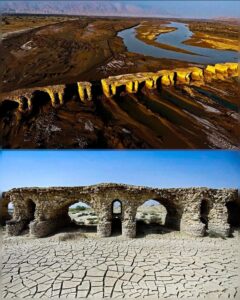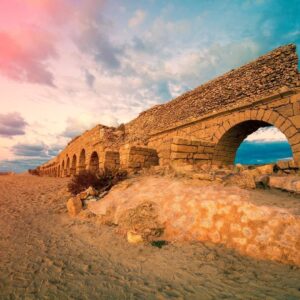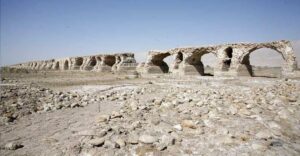Introduction
The Latidan Bridge is an architectural masterpiece from Iran’s Safavid dynasty, located in Hormozgan Province. Built in 1627 under Shah Abbas I, this bridge is not only a symbol of military strength during the war with the Portuguese but also a testament to the region’s economic and social development over the centuries. With its resilient design and remarkable structure, the Latidan Bridge has withstood the tests of time and natural forces, asserting its invaluable historical and cultural significance.

The Latidan Bridge under the Safavid Dynasty: Military Purpose and Strategy
Initially, the Latidan Bridge was built with a military purpose. During the conflict with the Portuguese, the Safavids saw the need for a quick route to transport troops and supplies across the area. The bridge’s structure was designed to support the weight of soldiers and equipment while withstanding the harsh climate and seasonal floods.
Using local materials and skilled construction techniques, Safavid architects created a bridge with impressive durability and flexibility. This feature reflects the strategic insight of the Safavid dynasty, which recognized the importance of a strategic connector like Latidan in securing national defense.

Transformation of the Latidan Bridge: From Military Point to Commercial Corridor
When the conflict ended, the role of the Latidan Bridge shifted. It was no longer just a military structure but gradually became a bustling commercial route, linking distant regions, boosting trade, and supporting the area’s economic development.
The transition from military to commercial use not only demonstrates the bridge’s flexibility and sustainability but also reflects the Safavid era’s social progress, as they understood that infrastructure connectivity was key to promoting commerce and connecting people. With the Latidan Bridge, Hormozgan Province became an essential gateway in Iran’s trade network, playing an indispensable role in expanding trade and economic growth.
Architecture and Construction Techniques: A Symbol of Safavid Architectural Skill
The Latidan Bridge is one of the longest stone bridges in Iran, and its structure showcases the talent and creativity of Safavid architects. Utilizing stone and local materials, the bridge possesses high load-bearing capacity and advanced construction techniques to withstand natural elements like heavy rains and frequent floods.
This sustainable architecture not only helped the Latidan Bridge endure for centuries but also made it a culturally significant heritage site, attracting researchers, historians, and tourists from around the world. The bridge still stands strong despite many challenges over time, making it a symbol of resilience and architectural mastery from the Safavid period.

Cultural Value and Historical Significance of the Latidan Bridge
More than an architectural structure, the Latidan Bridge is an important cultural heritage site, holding stories of history, military strategy, and economic development in the region. Its role transformation from a military base to a major trade route has made the Latidan Bridge a symbol of Iran’s cultural heritage adaptability and endurance.
Additionally, the bridge serves as evidence of sustainable construction techniques and the architectural talent of the Safavid period. Its near-intact structure through historical changes is a reminder of a time when Iran was a powerful cultural and economic hub, capable of creating structures that would leave their mark across centuries.
Conclusion
The Latidan Bridge is not only a physical heritage but also a symbol of Iran’s rich culture and history. With its significant role in both military and commercial contexts, the bridge exemplifies the adaptability and development of the Hormozgan region over centuries. Its lasting presence not only honors the talent and innovative thinking of Safavid architects but also solidifies the Latidan Bridge’s place as an irreplaceable cultural heritage site, contributing to Iran’s identity and tradition.
